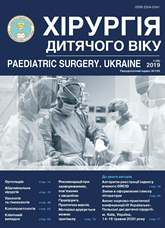An analysis of unsatisfactory results of treatment of acute appendicitis in children
DOI:
https://doi.org/10.15574/PS.2019.65.30Keywords:
acute appendicitis, children, complications, emergency surgeryAbstract
The issues of diagnosis and treatment of acute appendicitis in children are widely covered in the literature, however, early diagnosis, especially in infants, remains a difficult problem in pediatric surgery. The purpose of the work is to analyze the cases of unsatisfactory results of treatment of various forms of acute appendicitis in children.Materials and methods. We carried out а retrospective analysis of the diagnosis and treatment of 1034 children who were hospitalized in the department of emergency surgery of Vinnytsia region clinical pediatric hospital in the period from 2015 to 2018 with a diagnosis of acute appendicitis. Of these, 938 children were operated on for various forms of acute appendicitis and their complications. 69 (7.4%) children were operated on for the periappendicular abscess: boys – 42 (61%), girls – 27 (39%).
Results. Over the past 4 years, 76 children have been operated on with complicated forms of acute appendicitis, both for periappendicular abscess and for diverticulitis, ovarian apoplexy, primary peritonitis, torsion of the ovarian cyst. According to our data, the late hospitalization of children with a diagnosis of acute appendicitis in hospital facilities was associated with the economic and social difficulties of the rural and urban population. Underestimation of the general clinical symptoms of acute appendicitis by pediatricians, family medicine doctors and surgeons of district clinics and hospitals. All this led to the tactics of unreasonable observation and conservative treatment with an unknown diagnosis, especially in children of an early age group. It was more difficult to conduct differential diagnosis of acute appendicitis in children with an atypical location of the appendicular process. All these factors led to severe acute complications in children with frequent occurrence of periappendicular abscesses, which amounted to almost 30% of all operated children.
Conclusions. The high incidence of pre-hospital diagnostic errors in children with suspected acute appendicitis necessitates the need to improve the knowledge of emergency care for children of family physicians and general surgeons. The main method for the effective treatment of children with acute appendicitis is to solve the main problems through rational comprehensive treatment in a surgical hospital of a children’s hospital.
References
MOZ Ukrainy (2004). Pro zatverdzhennia Protokoliv likuvannia ditei zi spetsialnosti Dytiacha khirurhiia. Nakaz No.88-Adm vid 30.03.2004. http://search.ligazakon.ua/
Benabbas R, Hanna M, Shah J, Sinert R. (2017). Diagnostic accuracy of history, physical examination, laboratory tests, and point-of-care ultrasound for pediatric acute appendicitis in the emergency department: a systematic review and meta-analysis. Acad Emerg Med.24(5): 523-551. https://doi.org/10.1111/acem.13181; PMid:28214369
Benito J, Acedo Y, Medrano L, Barcena E et al. (2016). Usefulness of new and traditional serum biomarkers in children with suspected appendicitis. Am J Emerg Med. 34(5): 871–876. https://doi.org/10.1016/j.ajem.2016.02.011; PMid:26935221
Jaschinski T, Mosch C, Eikermann M et al. (2015). Laparoscopic versus open appendectomy in patients with suspected appendicitis: a systematic review of meta-analyses of randomised controlled trials. BMC Gastroenterol.15: 48. https://doi.org/10.1186/s12876-015-0277-3; PMid:25884671 PMCid:PMC4399217
Khanafer I, Martin DA, Mitra TP et al. (2016). Test characteristics of common appendicitis scores with and without laboratory investigations: a prospective observational study. BMC Pediatr. 16(1): 147. https://doi.org/10.1186/s12887-016-0687-6; PMid:27577252 PMCid:PMC5006246
Kollar D, McCartan DP, Bourke M, Cross KS, Dowdall J. (2015). Predicting acute appendicitis? A comparison of the Alvarado score, the Appendicitis Inflammatory Response score and clinical assessment.World J Surg.39(1): 104-109. https://doi.org/10.1007/s00268-014-2794-6; PMid:25245432
Mandeville K, Monuteaux M, Pottker T, Bulloch B. (2015). Effects of timing to diagnosis and appendectomy in pediatric appendicitis. Pediatr Emerg Care.31(11): 753-758. https://doi.org/10.1097/PEC.0000000000000596; PMid:26535497
Pogorelić Z, Rak S, Mrklić I, Jurić I. (2015). Prospective validation of Alvarado score and Pediatric Appendicitis Score for the diagnosis of acute appendicitis in children. Pediatr Emerg Care. 31(3): 164-168. https://doi.org/10.1097/PEC.0000000000000375; PMid:25706925
Salminen P, Paajanen H, Rautio T et al. (2015). Antibiotic therapy vs appendectomy for treatment of uncomplicated acute appendicitis: the APPAC randomized clinical trial. JAMA.313(23): 2340-2348. https://doi.org/10.1001/jama.2015.6154; PMid:26080338
Zingone F, Sultan AA, Humes DJ, West J. (2015). Risk of acute appendicitis in and around pregnancy: a population-based cohort study from England. Ann Surg. 261(2): 332-337. https://doi.org/10.1097/SLA.0000000000000780; PMid:24950289
Downloads
Issue
Section
License
The policy of the Journal “PAEDIATRIC SURGERY. UKRAINE” is compatible with the vast majority of funders' of open access and self-archiving policies. The journal provides immediate open access route being convinced that everyone – not only scientists - can benefit from research results, and publishes articles exclusively under open access distribution, with a Creative Commons Attribution-Noncommercial 4.0 international license(СС BY-NC).
Authors transfer the copyright to the Journal “PAEDIATRIC SURGERY.UKRAINE” when the manuscript is accepted for publication. Authors declare that this manuscript has not been published nor is under simultaneous consideration for publication elsewhere. After publication, the articles become freely available on-line to the public.
Readers have the right to use, distribute, and reproduce articles in any medium, provided the articles and the journal are properly cited.
The use of published materials for commercial purposes is strongly prohibited.

